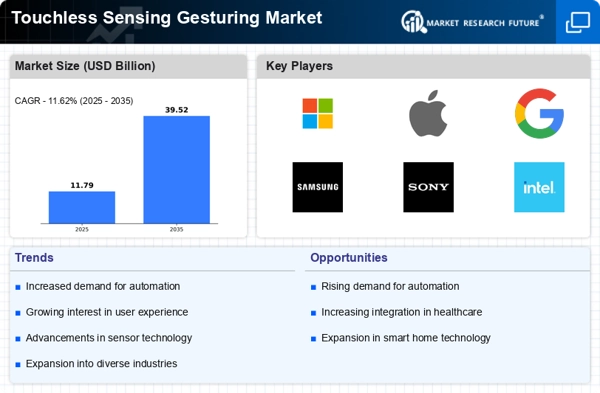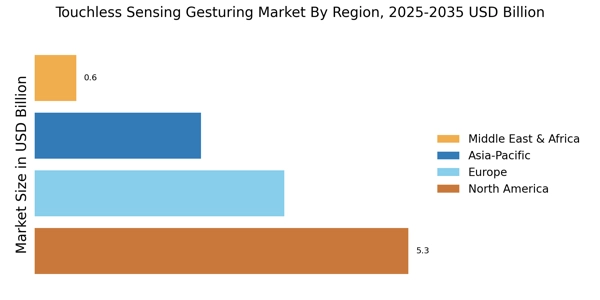Advancements in Machine Learning
Advancements in machine learning and artificial intelligence are significantly influencing the Touchless Sensing Gesturing Market. These technologies enhance the accuracy and responsiveness of gesture recognition systems, making them more reliable for various applications. As machine learning algorithms evolve, they enable devices to better understand and interpret human gestures, leading to improved user experiences. The market for machine learning in gesture recognition is projected to grow substantially, with estimates suggesting a potential increase of over 15% CAGR in the coming years. This growth is likely to be driven by the increasing integration of touchless gesturing in consumer electronics, automotive systems, and smart home devices. As a result, the Touchless Sensing Gesturing Market is poised to expand, as companies leverage these advancements to create more sophisticated and user-friendly products.
Integration with Augmented Reality
The integration of touchless sensing gesturing technology with augmented reality (AR) applications appears to be a driving force in the Touchless Sensing Gesturing Market. As AR continues to gain traction across various sectors, including gaming, education, and retail, the demand for intuitive interaction methods is likely to increase. This technology allows users to engage with digital content seamlessly, enhancing user experience. According to recent estimates, the AR market is projected to reach a valuation of over 200 billion dollars by 2025, which could significantly boost the adoption of touchless gesturing solutions. Companies are increasingly investing in developing AR applications that utilize touchless gestures, thereby creating a symbiotic relationship between these two technologies. This trend suggests a promising future for the Touchless Sensing Gesturing Market as it aligns with the growing need for immersive experiences.
Rising Demand for Contactless Interfaces
The rising demand for contactless interfaces in various industries is a notable driver for the Touchless Sensing Gesturing Market. As consumers become more conscious of hygiene and safety, businesses are increasingly adopting touchless technologies to minimize physical contact. This trend is particularly evident in sectors such as retail, healthcare, and transportation, where touchless interfaces can enhance user experience while ensuring safety. Market analysis indicates that the touchless technology segment is expected to grow at a compound annual growth rate (CAGR) of approximately 20% over the next few years. This growth is likely to be fueled by the increasing implementation of touchless kiosks, smart displays, and gesture-controlled devices. Consequently, the Touchless Sensing Gesturing Market stands to benefit from this shift towards contactless solutions, as organizations seek to provide safer and more efficient interactions.
Growing Applications in Automotive Sector
The growing applications of touchless sensing gesturing technology in the automotive sector represent a significant driver for the Touchless Sensing Gesturing Market. As vehicles become increasingly equipped with advanced infotainment systems, the need for intuitive and safe interaction methods is paramount. Touchless gesturing allows drivers to control navigation, music, and other features without taking their hands off the wheel, thereby enhancing safety. Recent projections indicate that the automotive gesture recognition market could reach a valuation of over 10 billion dollars by 2026. This growth is likely to be fueled by the rising demand for enhanced user experiences and the integration of smart technologies in vehicles. Consequently, the Touchless Sensing Gesturing Market is expected to benefit from this trend as automotive manufacturers seek to implement innovative touchless solutions.
Increased Investment in Smart Home Devices
The increased investment in smart home devices is emerging as a key driver for the Touchless Sensing Gesturing Market. As consumers seek to enhance their living environments with automation and convenience, the demand for touchless control systems is likely to rise. Smart home devices that utilize gesture recognition technology offer users a seamless way to interact with their environments, from controlling lighting to managing entertainment systems. Market Research Future indicates that the smart home market is expected to surpass 100 billion dollars by 2025, which could lead to a corresponding increase in the adoption of touchless gesturing solutions. This trend suggests that manufacturers are likely to prioritize the integration of touchless interfaces in their products, thereby propelling the growth of the Touchless Sensing Gesturing Market.

















Leave a Comment